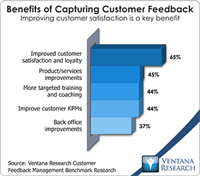Clarabridge is a well-known text analytics vendor that markets its products under the banner of customer experience management. As I wrote last year, its products allow organizations to take a closed-loop approach by capturing all forms of text data, analyzing it, categorizing it, understanding root causes of customer issues and raising alerts so that action including collaboration can be taken based on these insights. Such a process is supportive of customer experience management, but for me...
Read More
Topics:
Social Media,
Customer Analytics,
Customer Experience,
Speech Analytics,
Clarabridge,
Mobile Apps,
Collaboration,
Customer & Contact Center,
Customer Service,
Call Center,
Contact Center,
Contact Center Analytics,
CRM,
Text Analytics,
Unified Communications
Clarabridge is an established vendor of text analytics products, which it sells both directly to the market and indirectly through an extensive set of partnerships with companies such as MicroStrategy, IBM Cognos and Verint. Recently it has been marketing its applications under the category of customer experience management (CEM). To me, CEM is about personalizing and influencing the customer experience while an interaction is in progress. Organizations cannot do this without the right...
Read More
Topics:
Predictive Analytics,
Social Media,
Customer Analytics,
Customer Data Management,
Customer Experience,
Customer Feedback Management,
Social CRM,
Speech Analytics,
Voice of the Customer,
Clarabridge,
Operational Performance,
Analytics,
Cloud Computing,
Customer & Contact Center,
Customer Service,
Call Center,
Contact Center,
Contact Center Analytics,
CRM,
Desktop Analytics,
Text Analytics,
Unified Communications,
Workforce Management
I have been doing research into customer relationship management (CRM), contact centers and analytics for seven years. Throughout that time some customer-related themes have remained constant: Companies say their top driver is to improve customer satisfaction; customer experience management (CEM) has overtaken CRM as a top priority; and companies still search for a 360-degree view of the customer (which now is often called “the voice of the customer”). For many companies these themes remain...
Read More
Topics:
Customer Experience,
Clarabridge,
IT Performance,
Operational Performance,
Information Management,
Text Analytics










